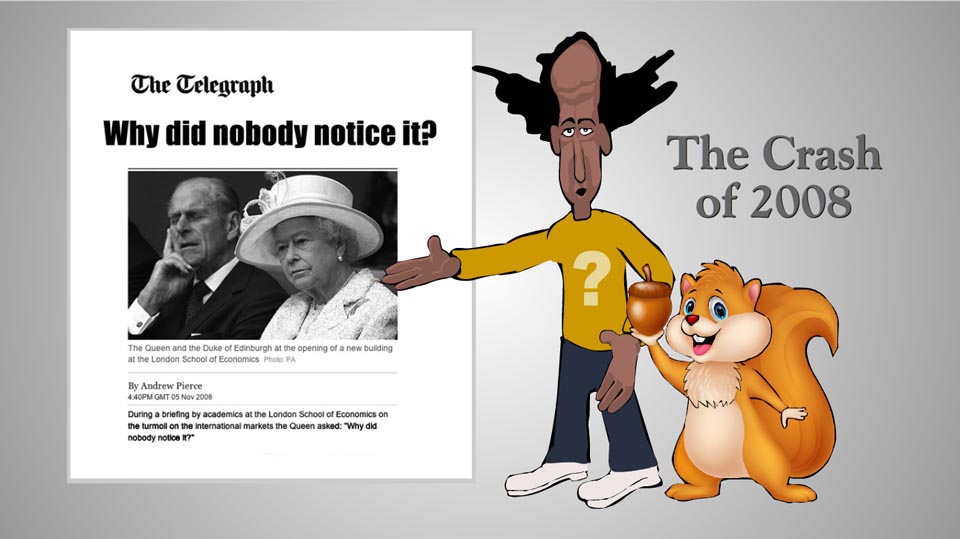|
site map / view all movies / contact See Economists and a Pile of Nuts
The Confusion about Savings No one disagrees that banks create money from the borrowers’ promises to pay it back. However, disagreement arises when one side claims that Banks NEVER lend their depositors’ money. This side claims that banks always create new money against new debt. According to this side of the argument, Principal Debt within the banking system can never exceed the Principal created by that debt. P of money = P of debt that created it. The other side of the argument claims that banks ALSO effectively lend the depositors’ money deposited (ie. loaned to the bank) in savings accounts, thus lending the same money twice and creating a fundamental shortage of Principal. P of Principal < 2P of debt of that Principal. The first side claims that if the banks always create new money against new debt the second claim cannot be true. The following demonstration will explain why that reasoning is in error. Both are true. There is no contradiction. There is only a misunderstanding of what savings really are. Let us suppose our theoretical bank has a required capital adequacy of one (1) billion dollars. Using the Basel Accords most stringent requirement of 8% capital adequacy, the bank may, therefore, create up to 12.5 billion dollars of liabilities against itself to pay legal tender on demand. Note that 92% of these liabilities are by definition fraudulent because the bank doesn’t have either the legal tender or enough valuable assets to sell to obtain it. Even without regulation, banks would have to set a limit based on their capital resources and appetite for risk. So, following the most stringent Basel Accords requirement, Total Principal creation by the bank is limited to 12.5 billion dollars. In order to have balanced books, the banks liabilities must equal its assets and that requires the bank to have 12.5 billion dollars in performing loans. So far P of debt = P of money to pay it. Performing loans are the bank’s income-earning assets. DEMAND deposits are the CURRENT liabilities of the bank. Note the words “current” and “demand” and recall that bank credit money is a “promise of legal tender on demand’. The so-called “money” we park in savings, particularly term deposits which make up the vast majority of all money, cease to be current liabilities of the bank because the savers have promised not to demand legal tender or transfer the deposits elsewhere for the term of the agreement. With savings and term deposit liabilities REMOVED from the bank's balance sheet, the bank may now create new money against new debt up to the capital adequacy limit prescribed, which is still 12.5 billion dollars. Therefore, if the bank has removed 9 billion dollars in term deposit liabilities from its current balance sheet, it is allowed to create 9 billion dollars in new debt TO REPLACE IT. This is exactly the same mathematically as actually re-lending the depositors’ money, which is why it is legitimate to call savings “loanable funds”. There is now a total Principal Debt of 21.5 billion dollars with only 12.5 billion of created Principal available to pay it. Impossible debt has been created and we haven’t left the bank yet. Any of this Principal that is already lent twice could be lent again or deposited in yet another term deposit n times where n is a complete unknown. There is no theoretical limit to how many times money created as debt can be lent again in series. Therefore, the only possible conclusion is that Total Principal Debt is completely unknown and significantly EXCEEDS the supply of created Principal with which to pay it. P of Principal < nP of debt of that Principal , n > 1 But Impossible Debt needn’t create massive defaults as long as the supply of new bank credit/borrower debt keeps growing. In normal times of growth, the foreclosure rate is less than 1%, clear evidence that Borrowers DO earn the Principal plus Interest, pay it back and extinguish it. But now what? There may be 3 or 4 outstanding debts dependent on paying and re-lending that Principal. New debt-money creation must be forthcoming on time to prevent 3 or 4 defaults. Impossible Debt creates an ever accelerating treadmill of ever-escalating Perpetual Debt, an inescapable trap of borrowing from Peter to pay Paul and vice versa that can never be reduced or slow down without causing mathematically inevitable defaults due to a very REAL shortage of Principal. And thus we experience the periodically necessary crashes that wipe out the debt overhang by foreclosing on borrowers who cannot pay their debts simply because total debt exceeds total money by the design of the banking system itself, and not through any fault of the brrowers.
|
